Poás volcano field workshop—Summary of the week
For a week in February 2024, a group of ~30 scientists came together to experiment with novel instrumentation on Poás Volcano in Costa Rica. Individuals from 5 countries responded to an open call for participation, and the final group of 19 joined 8 scientists from OVSICORI (Observatorio Vulcanológico y Sismológico de Costa Rica) and RSN-UCR (University of Costa Rica), AVERT leaders Conor Bacon and Terry Plank, and Moore Foundation Program Associate Rebecca Ju to commune on the volcano. Poás had been highly active in January and early February 2024, erupting plumes of steam and mud up to 300 m high in phreatic explosions several times a day. Fortunately, the volcano stopped its activity while scientists worked around its rim and crater from February 17-24 to deploy instruments during the field workshop. We anticipate renewed activity anon.
Participants met each other and shared their motivations and goals in a kick-off meeting on Sunday, February 18, at the Poás Volcano Lodge. This was an opportunity to see the full scope of work planned and to form groups that would collaborate throughout the week.
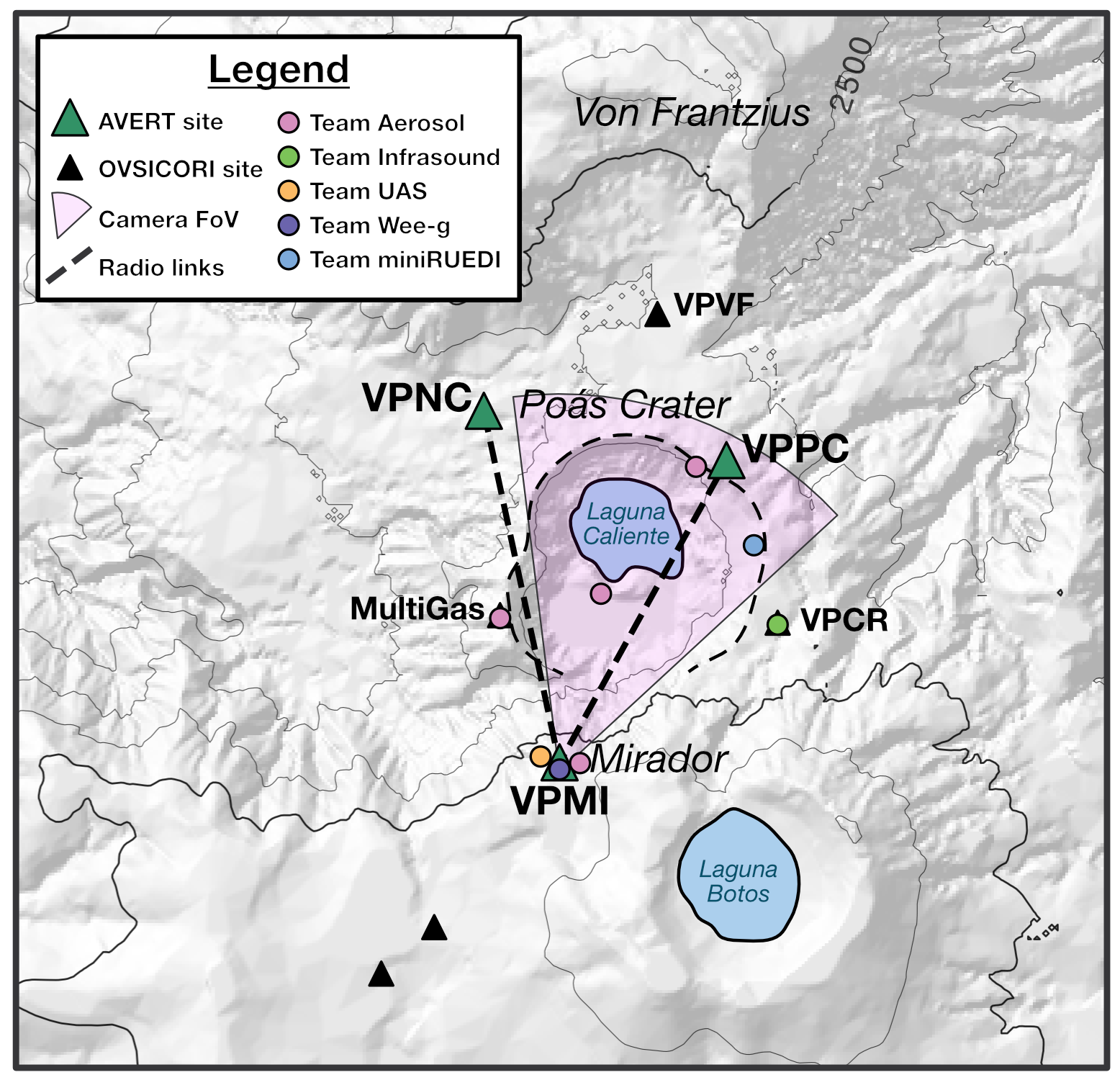
Map of the permanent sites (indicated by triangles) around the Poás crater area, with individual sampling sites for each team indicated with different coloured circles.
Team miniRUEDI One team led by Woods Hole scientist Alan Seltzer and postdoc Michael Broadley planned to deploy a portable quadrupole mass spectrometer, the “miniRUEDI,” to measure noble gases (e.g., 4He and 40Ar) in situ for at least 24 hours continuously in autonomous operation. The 70 lb pelican case that contained the miniRUEDI quickly became the target of discussions surrounding the definition of “portable.” As Seltzer portrayed at the kick-off meeting, simply carrying the mass spec, batteries, and solar panels onto the crater rim would be an accomplishment! EarthScope engineer Wade Johnson, consultant Carlos (Bam Bam) Ramirez, and graduate student from the University of Napoli (Italy) Bernardo Barosa quickly volunteered to help the team throughout the week. The end goal would be a time series of noble gas, nitrogen, carbon, and sulfur ratios that might signal subterranean magma movement under Poás. Such novel measurements would complement existing gas measurements using MultiGas (e.g., H2O, CO2, SO2, H2S, and Cl) which have been so useful in providing precursors to Poás's activity (de Moor et al., 2016, 2019). The miniRUEDI may measure new precursors or illuminate new processes occurring in Poás's extensive hydrothermal system.
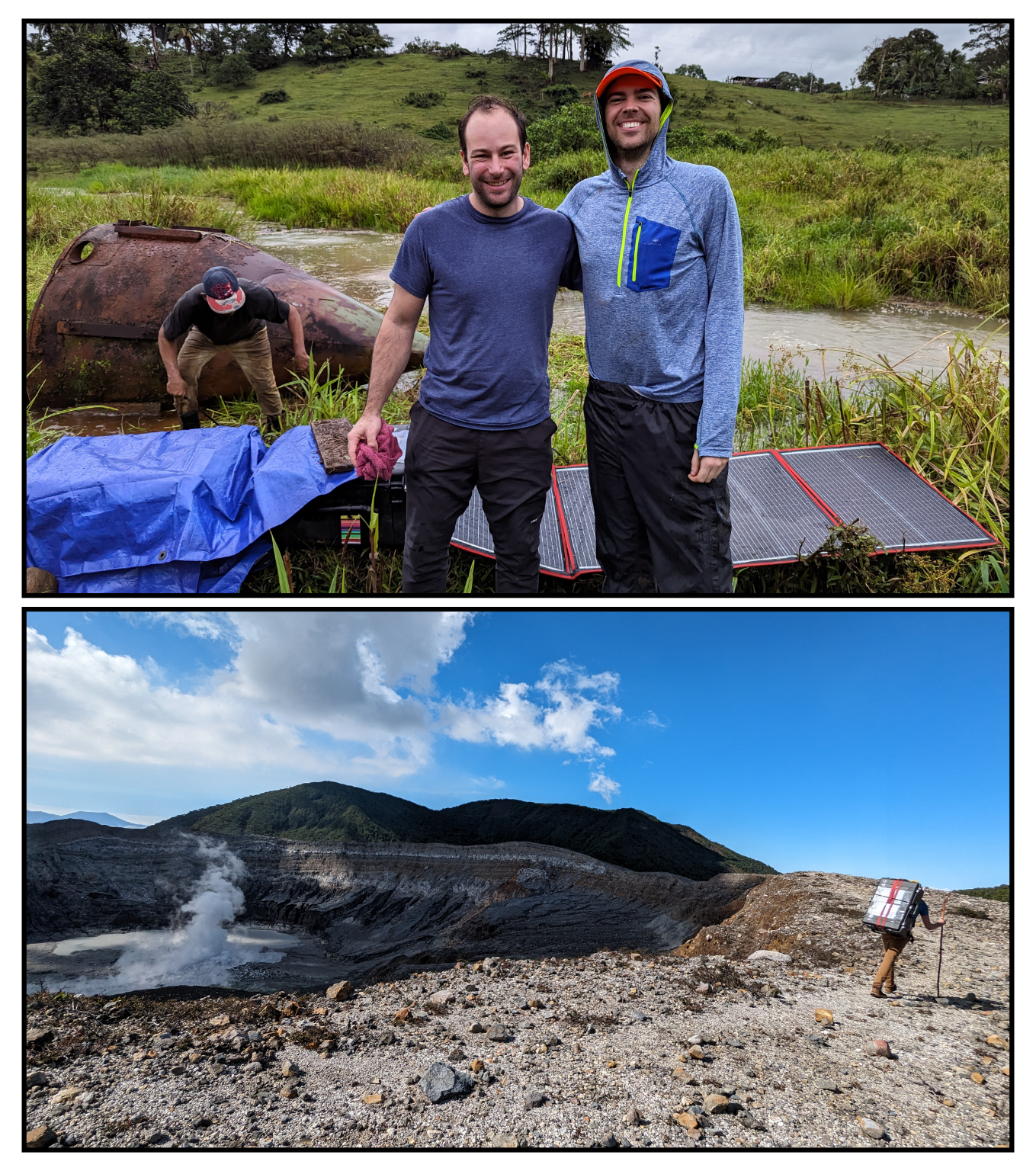
Team miniRUEDI. Top: Alan Seltzer and Mike Broadley in front of the deployed miniRUEDI system at Pompilio Springs, in the back arc. Bottom: The miniRUEDI system being hiked along the Poás crater rim prior to deployment above the fumarole bank. The Laguna Caliente and plume are visible to the left, with the Von Frantzius peak in the background.
Team Wee-g. Another team consisting of postdoc Kristian Anastasiou and graduate student Libby Passey from the Institute for Gravitational Research at the University of Glasgow planned to deploy a MEMS-based micro-gravimeter—the same technology used in, e.g., mobile phones—to measure small mass movements on and under the volcano. The name “Wee-g” is a play on both the tiny gravity signals they hoped to measure and the instrument's Glaswegian provenance. Although tested extensively in the lab, the main goal was to field-test the instrument for sensor stability and environmental changes. Following pioneering work by Rymer and Brown who measured microgravity changes on Poás in the 1980s (Nature, 1984), the Wee-g team hoped to record small mass changes related to the crater lake and subterranean hydrology.
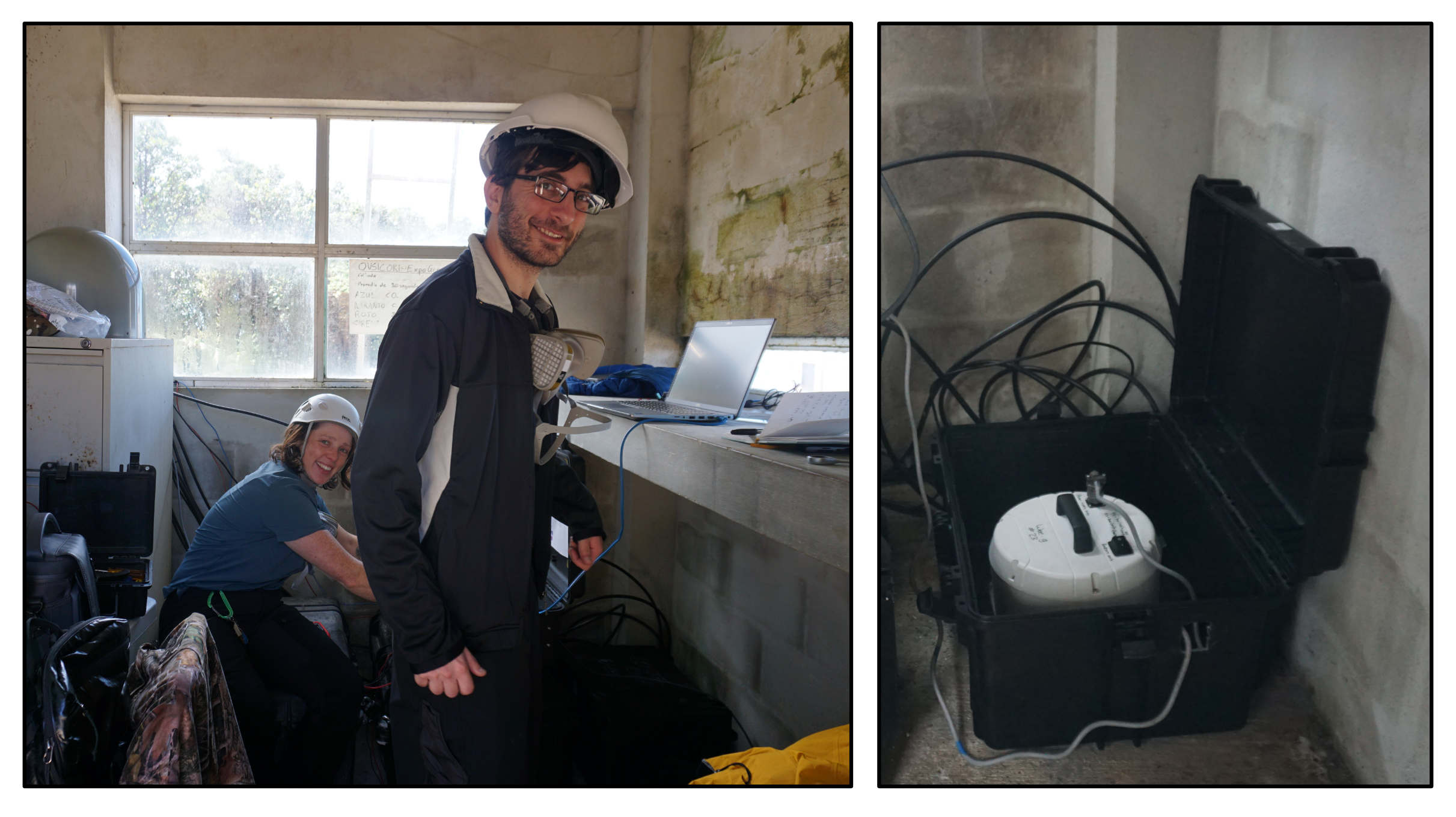
Team Wee-g. Left: Libby Passey and Kris Anastasiou working in the Mirador hut, installing the Wee-g gravimeter next to the AVERT control box. Right: The Wee-g itself, deployed inside a protective case that is bolted into the concrete to protect the sensitive instrument from bumps and knocks.
Team UAS. The VolCAN Project at the University of New Mexico sent a big team of personnel and drones to map gas fluxes at Poás crater. PI Melanie Moses, co-PI's Scott Nowicki, Matthew Fricke, Rafael Fierro, and Research Assistants Carter Frost, John Ericksen, and Felipe Rojas Vilches hoped to fly multiple Unpiloted Aerial Systems (UASs), in concert, with multiple sensors to create the first 3-D map of CO2 concentrations at Poás crater. Their bespoke Unpiloted Aerial System, called the DragonFly, is capable of flying in formation (as a “swarm”) with a robotic operating system to guide the detection of CO2 and actively map out a plume's boundary. With such a vigorous gas plume, Poás is an excellent test bed to compare UAV-flown sensors with autonomous MultiGas and DOAS stations, on-foot traverses, and the miniRUEDI.
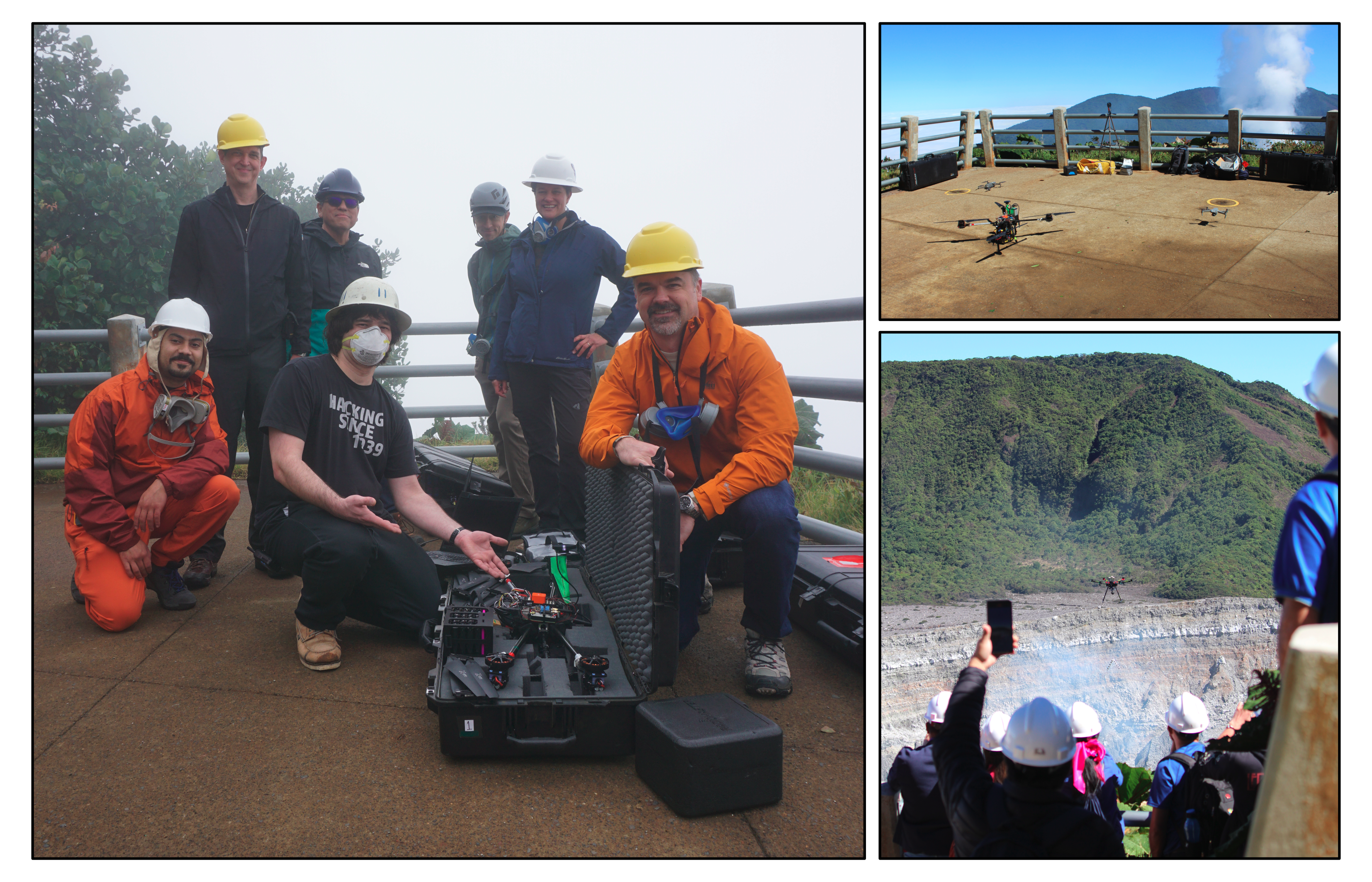
Team UAS. Left: The full VolCAN team poses with one of their bespoke DragonFly UAS on the first day. From left to right: Felipe Rojas Vilches, Matthew Fricke, Rafael Fierro, Carter Frost, Scott Nowicki, Melanie Moses, and John Ericksen. Top right: Take-off! The team took over one of the lower platforms at the Mirador as their launch base. Bottom right: Tourists enjoy the spectacle of the DragonFly UAS flying out into the crater.
Team Infrasound. The original goal for the team from Université Libre de Bruxelles, Associate Professor Corentin Caudron, and postdoctoral researcher Ben Roche, was to deploy hydroacoustic sensors in the crater lake of Poás. The recent eruptive activity had greatly diminished the size of the lake and also rendered such inquiry dangerous. Instead, the ULB team brought several infrasound sensors to deploy as an array on the rim of Poás, at the existing seismic site VPCR, along with Leonardo van der Laat, John Bolaños Paniagua, Henriette Bakkar Hindeleh, and others at OVSICORI. The infrasound array would complement the sole sensor further from the crater at von Frantzius cone (VPVF), and provide not only more proximal signals but also the ability to better locate the source of volcano noise to model eruption dynamics.

Team Infrasound. Left: Corentin Caudron (left) and Ben Roche (right) visit the OVSICORI headquarters to prepare the infrasound deployments. Right: Ben Roche shows off one of the installed infrasound sensors on the eastern side of the crater rim.
Team Aerosol. How harmful are volcanic plumes to your respiratory health, and what kinds of lifeforms do they carry? These were the questions being asked by two scientists interested in filtering the Poás gas plume to study particles, toxic metals, and microbial diversity: Professor Donato Giovanelli at the University of Naples Federico II and graduate student Mushtari Saidikova from the University of Cambridge, in the UK. This team was joined by Maarten de Moor Geoffroy Avard from OVSICORI and Paulo Ruiz from the University of Costa Rica to make parallel measurements of plume particulates and gas chemistry.

Team Aerosol. Clockwise, from top left: team “Vertical Ascent” hiking out from Poás crater with sampling equipment after successful deployment right next to the plume source. Mushtari Saidikova preparing sampling equipment at a school downwind of the plume. Mushtari Saidikova on the crater rim with sampling equipment deployed. Donato Giovanelli and Bernardo Barosa in front of Poás crater. Donato Giovanelli sets up his low-cost sampling pump with specially designed 3-D printed fitting on a tripod. Team Aerosol setting up sampling equipment on the rim above the crater lake accompanied by the Red Cross, OVSICORI scientist Maarten de Moor, and Moore Foundation Program Associate Rebecca Ju.
Team Water Sampling: A group from the Atmospheric Chemistry Lab at the Universidad Nacional de Costa Rica (LAQAT-UNA) set out to collect samples from the hyperacidic crater lake at Poás volcano. Due to the unsafe conditions, these could not be collected on foot, so a bailer bottle on a rope system was deployed using a Matrice 600 Pro drone. The goal is to collect such samples at regular intervals, including during the workshop, to analyse the time evolution of the pH and chemical species contained in the water.
Team AVERT: The AVERT Team from Lamont Doherty Earth Observatory of Columbia University (post-doc Conor Bacon, PI's Terry Plank and Einat Lev, and engineer Nick Frearson) joined forces with many OVSICORI scientists and students in November 2023 to build out the Poás monitoring network in the lead-up to the workshop. In less than a week, they established four new sites on the volcano, two on the crater rim (VPNC, VPPC) and two in the north where no instruments existed previously (VPCC and VPRS). Here they established four new broadband seismometers, three fluxgate magnetometers, and a new GNSS and CO2 soil probe that are broadcasting openly and continuously, densifying the array on Poás for geophysical imaging in the run-up to eruption. The soggy and muddy week of fieldwork was documented in an article and video: High in a Cloud Forest, Tapping Into the Breathing of a Volcanic Beast
For the February field workshop, the AVERT Team still had work to do testing the new Starlink hardware for satellite-based internet for data telemetry from the crater sites and Poás Mirador. Starlink was developed for commercial use and not monitoring volcanoes! The antenna had to be adapted to run directly from a 12 V DC power supply, bypassing the redundant WiFi router and the single-board computer configured to properly route the internet connection. Conor Bacon and John Bolaños Paniagua led this work. Data recorded at all sites in the crater area pass through the Mirador site and are transmitted via the Starlink internet connection back to the AVERT server at the Lamont-Doherty Earth Observatory, where they are made publicly available through the AVERT website and other servers that are open to real-time data storage and access. Another goal was to deploy an infrared camera at the Mirador to provide images of the volcano at nighttime, of heightened interest since the appearance a few days earlier of incandescent sulfur on the lake!
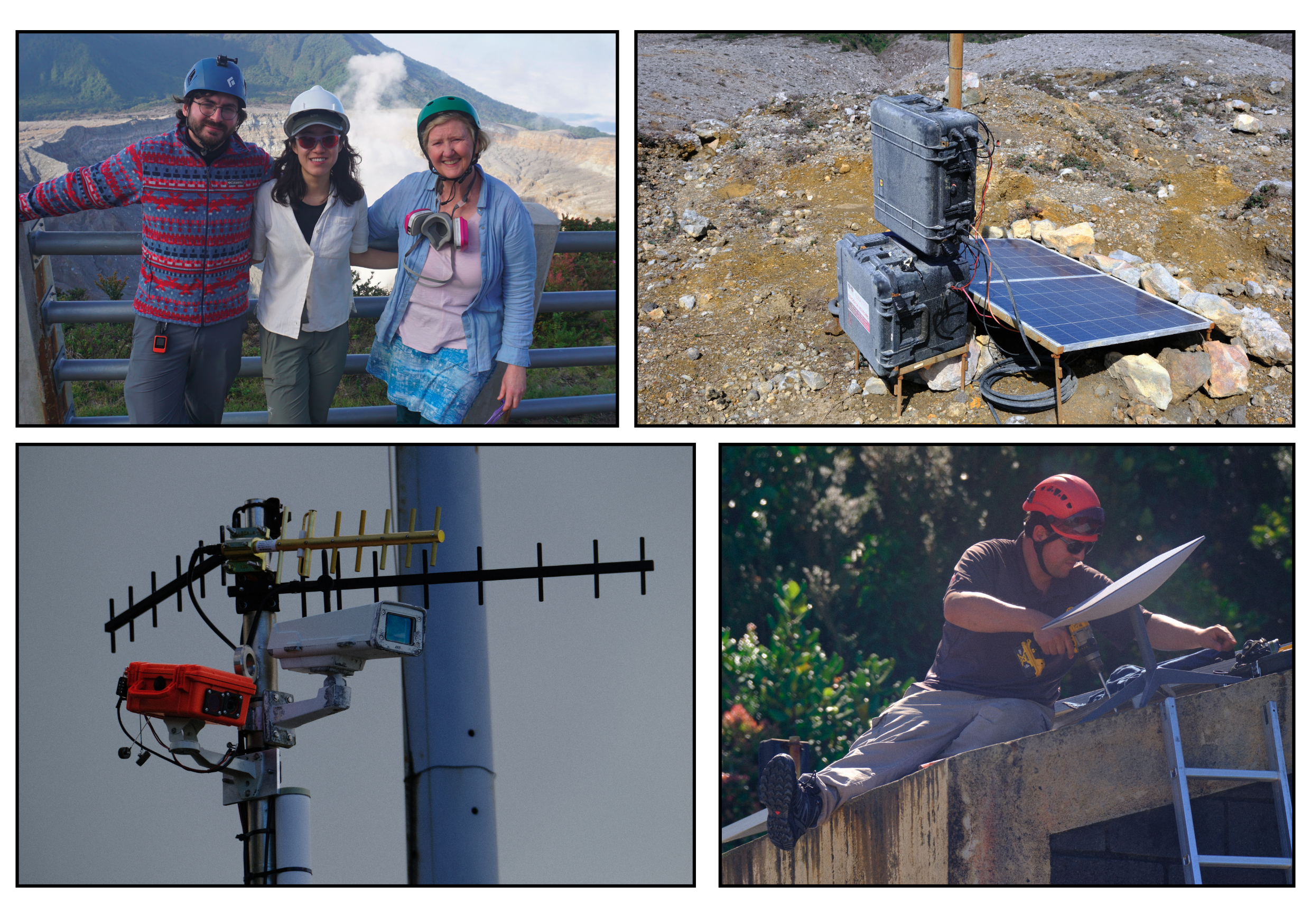
Team AVERT. Top left: AVERT post-doc Conor Bacon, Lamont Data Science Fellow Sarah Shi, and AVERT PI Terry Plank at the Mirador. Top right: One of the sites deployed in November showing the effects of the acid gases that come off the crater lake. Bottom left: The new dual-camera system (including IR and visible spectrum cameras, in the orange Pelican case) alongside the existing OVSICORI webcam and radio telemetry array. Bottom right: John Bolaños Paniagua installing the Starlink dish on top of the Mirador hut.
With the goals clearly articulated and all equipment having arrived, the teams were ready to mobilize around Poás for the week. Our assortment of rental and personal vehicles were made official AVERT-OVSICORI project vehicles by way of a nifty magnetic AVERT-OVSICORI sign, providing coherence and expedited access for the group to the national park.
Monday, February 19
The entire group met at the Poás visitor's center cafeteria for a safety briefing and deployment strategy. Maarten de Moor provided an assessment of the current volcano activity, highlighting some of the more concerning signals that had been observed in the days before. Seismic tremor and SO2/CO2 gas ratios had increased over the weekend, and the tremor frequency dropped suddenly overnight. A decision was made to confine the day's work to the Mirador, especially with rains coming in over the afternoon. Each group got to work testing equipment. The miniRUEDI made stable air measurements, and because the plume was wafting toward the Mirador, the Aerosol Team set up their filters and pumps nearby with the OVSICORI portable MultiGas, to make all these measurements simultaneously. Team UAV made a test flight; Team Infrasound deployed a sensor in the woods as a test. At the Mirador bunker, the Wee-g was fired up and tests were made with the Starlink and IR camera. It turned out to be a great group activity to field test everything together in the same place, to learn further what each team was doing, and to co-locate tests. Many groups brought equipment back to El Churrasco Hotel for the evening for further tweaking and repairs.

Day 1: The teams gather for an early morning briefing at Mirador.
Despite this being the dry season in Costa Rica, a major storm moved in from the Caribbean and dumped rain with heavy winds on Poás Tuesday and Wednesday. Most field plans were scuttled due to the poor visibility and rain, but miniRUEDI and Aerosol Teams returned to the Mirador to gather equipment and assess preliminary data. Mushtari and Paulo visited the Jacinto Paniagua Rodríguez School in Carbonal de Grecia (where strong odors and volcanic gases had been reported a few days earlier) and set up the air filters to run overnight. The infrasound team met at OVSICORI headquarters in Heredia to build out the array. The Wee-G team and Conor continued to troubleshoot some of the issues that had arisen on Monday, aiming to have their corresponding instruments ready for deployment as soon as the rains had passed.
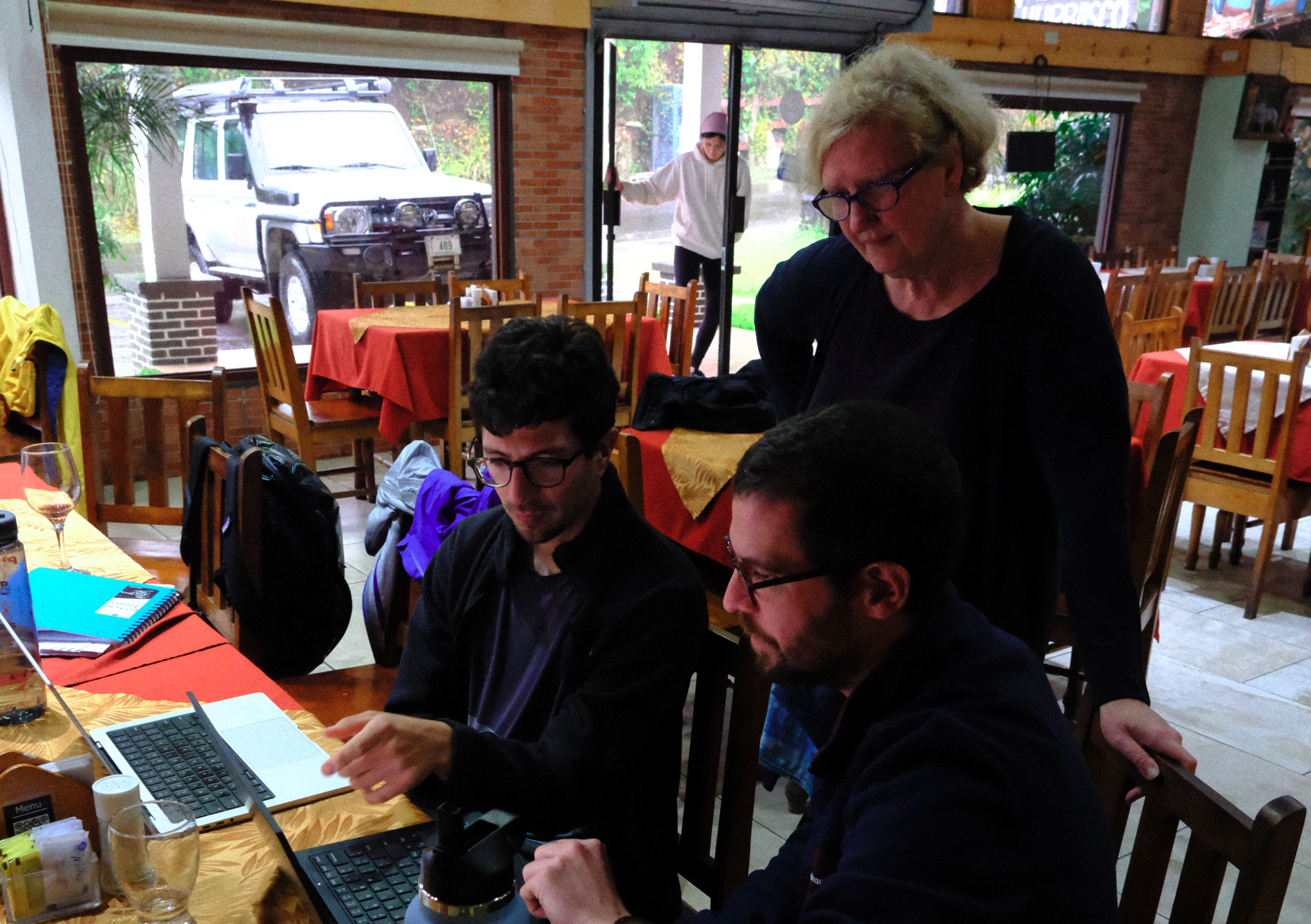
Leo van der Laat (sitting, left, OVSICORI), Terry Plank (standing, LDEO), and Corentin Caudron (sitting, right, ULB) review time series data from Poás at El Churrasco while field activities are rained out.
Wednesday: February 20 Most of the group met with optimism at the Poás cafeteria again, but not without first dodging downed trees from the storm's high winds and the park suffering power outages. With the Poás Volcano National Park closed, weather claimed another day for most of the group. Team miniRUEDI took off for the back arc to deploy the instrument overnight at Pompilio CO2-rich, bubbling spring (~ 1 hour north of Poás). Team Infrasound spent another day at OVSICORI to complete the construction of the array. The rest of the teams hunkered down at the lodging, reviewing some of the initial data and preparing for the following days, which promised to bring much improved weather conditions.
Thursday, February 21
Calm conditions (for both the weather and the volcano activity), brilliant skies, and a vigorous gas plume met participants at the Mirador, and Teams dispersed to get to work. UAV Team had perfect conditions for flying more than 20 flights, with CO2 sensors, the MultiGas, and visible and IR cameras. Team Infrasound successfully established a three-sensor array at VPCR. The first IR images went out over a new Starlink connection. The Wee-g was operational but work was still needed to connect to the telemetry. The miniRUEDI team collected the equipment from the Pompilio spring after 18 hours of successful data collection and deployed the instrument on the crater rim for overnight measurements of the eastern fumarole bank. Team Aerosol were challenged by a vertical plume (due to the lack of wind) that was out of reach along the crater rim. With the All Clear from the main OVSICORI office—received using the new Starlink connection at Mirador, as the cell network was still out from the storm—the team decided to descend into the crater to collect samples at the crater lake.
Friday, February 22
Shifting winds and excellent visibility led to another highly productive day on Poás. At one point there were six separate Teams spread out all around the crater rim. By the end of the day, each team found success:
• Team miniRUEDI lowered an 80-meter length of tubing along the crater wall to tap into a fumarole and measured co-arriving peaks of 4He, CO2, and SO2. Such signals measured in the Poás fumarole and the Pompilio CO2 spring may represent the first successful in-situ monitoring of geological 4He, to our knowledge. With important lessons learned, the Team plans to use these pilot data for future miniRUEDI measurements of volcanic gases.
• The Wee-g was successfully installed, thermalized, tilt-adjusted, and re-calibrated on-site. Communication with the AVERT system via Bluetooth and Starlink was established, enabling a proof of concept for the versatility of the AVERT system, as well as joining only a handful of similar systems around the world to be continuously monitoring small changes in gravity on a volcanic system.
• Team UAV successfully completed six high-altitude missions including multiple transects of the plume, vertical transects into the caldera, and “lawnmower”-style mapping of CO2. Additionally, there were four successful MultiGas flights that will provide CO2/SO2 ratios of the plume gas, and several camera flights (visible, near IR and IR). Already the group has obtained what might be the first CO2 concentration map across an entire active crater.
• Team Infrasound successfully established a new 4-component infrasound array, with 3 components telemetered in real time to OVSICORI. Now we are ready for some explosions!
• Team Aerosol collected exceptionally near-source (at the crater lake edge) and distal air samples for health assessments. Other samples (for aerosols and biology) were co-located along the crater rim with simultaneous Multi-gas measurements. These are novel samples, and Paulo may continue sampling at the Carbonal area as part of a new collaboration.
• Team Water Sampling collected a water sample from “Boca A” in the hyperacid lake (10°11'46.25'' N, 84°13'50.62'' W), which will be compared with other samples collected earlier in 2024. This measurement came after a number of days of fresh rainfall had brought the lake level up to a point higher than it had been in early January, so it will be interesting to compare with samples through time.
• Team AVERT added 4 seismometers, 1 GNSS, 3 fluxgate magnetometers, a CO2 soil probe, a co-located simultaneous visible and IR camera, and satellite telemetry. Poás is now the best monitored volcano in Costa Rica and ranks among the best in the world for diverse measurements. Instruments are in place to record and make openly available signals in the run-up to the next eruption.
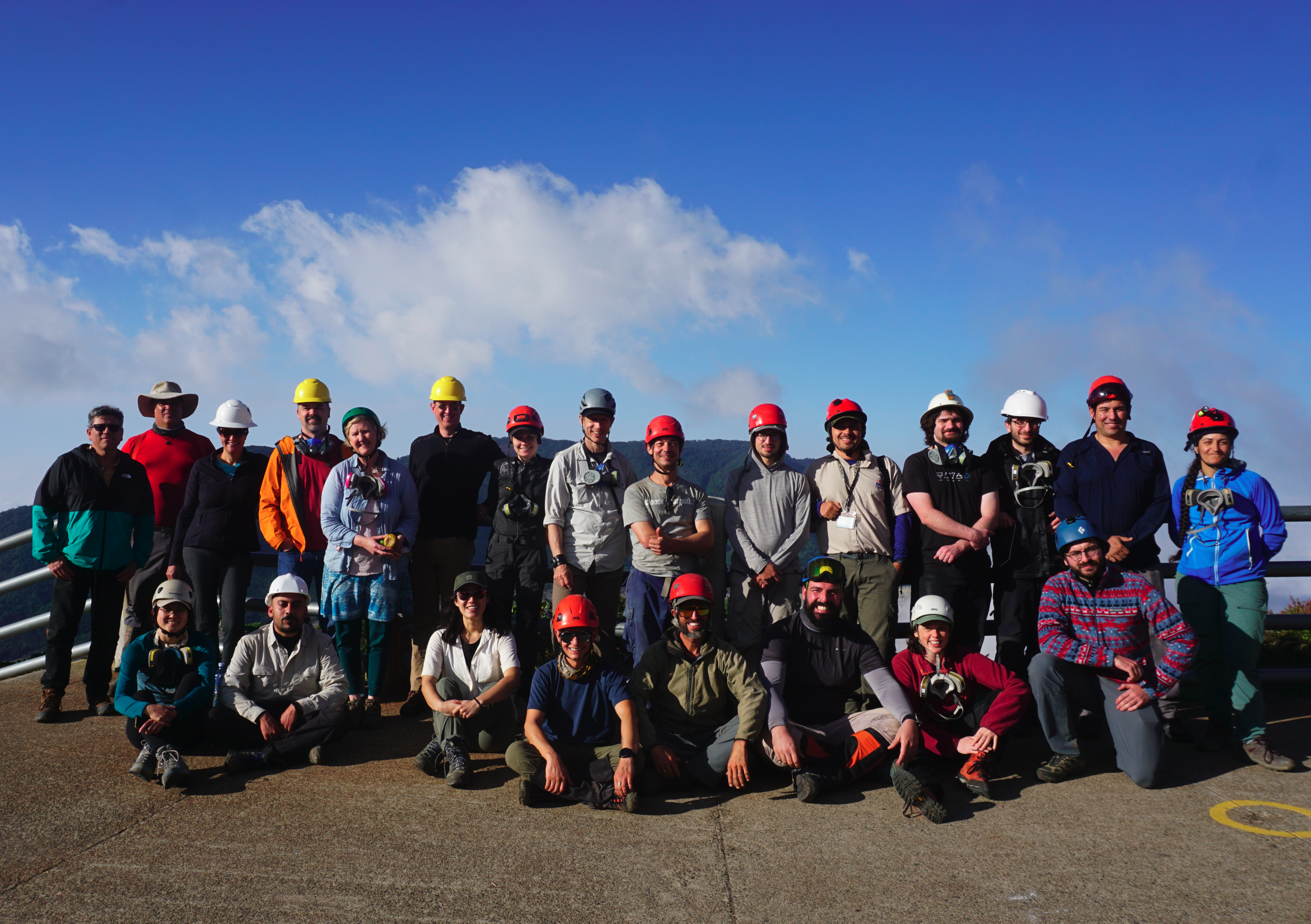
The (majority of) the workshop participants gather for a group photo at the Mirador on the final day.
After a final debriefing and fine dinner at the Poás Volcano Lodge, participants started their journeys home, with plans to meet up virtually to discuss preliminary results, followed by an in-person workshop at Lamont later in 2024. More results to come!
References
Rymer, H. and Brown, G.C., 1984. Periodic gravity changes at Poás volcano, Costa Rica. Nature, 311(5983), pp.243-245.
de Moor, J.M., Aiuppa, A., Pacheco, J., Avard, G., Kern, C., Liuzzo, M., Martinez, M., Giudice, G. and Fischer, T.P., 2016. Short-period volcanic gas precursors to phreatic eruptions: Insights from Poás Volcano, Costa Rica. Earth and Planetary Science Letters, 442, pp.218-227.
de Moor, J.M., Stix, J., Avard, G., Muller, C., Corrales, E., Diaz, J.A., Alan, A., Brenes, J., Pacheco, J., Aiuppa, A. and Fischer, T.P., 2019. Insights on hydrothermal-magmatic interactions and eruptive processes at Poás Volcano (Costa Rica) from high-frequency gas monitoring and drone measurements. Geophysical Research Letters, 46(3), pp.1293-1302.